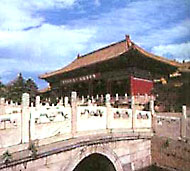 The Working People?s Cultural Palace lies to the east of Tian?anmen Rostrum, symmetrically opposite Zhongshan Park. The large park stretches from Tian?anmen Rostrum in the south to the Forbidden City moat, and from the East Thousand Bu Corridor before the Imperial Palace in the west to the eastern palace walls-fully one half the width of the Forbidden City. The park was originally built in 1420 as a large-scale temple.
The Working People?s Cultural Palace lies to the east of Tian?anmen Rostrum, symmetrically opposite Zhongshan Park. The large park stretches from Tian?anmen Rostrum in the south to the Forbidden City moat, and from the East Thousand Bu Corridor before the Imperial Palace in the west to the eastern palace walls-fully one half the width of the Forbidden City. The park was originally built in 1420 as a large-scale temple.
The central part of the park consists of three magnificent halls, each with its own auxiliary halls. The front hall, the largest of the three, has a double-eaved roof and tests on a three-layer stone base. Before it to the south is a spacious courtyard with long corridors enclosing it on each side. At the southern end of the courtyard is a compound with a pavilion and several exquisite stone bridges spanning the Golden River (Jinshuihe). A forest of ancient cypress trees surrounds these buildings, which, with their strong yet simple style, from a single integrated whole with the Imperial Palace.
In the past, the temple was known as the Imperial Ancestral Temple and served as a repository. During the Ming and Qing dynasties, on occasions such as an emperor? s ascending the throne, a triumphant return from battle or the presentation of prisoners of war, the emperor would first come here to offer sacrifices to his ancestors.
At other times, the huge temple stood empty except for the few bailiffs who guarded the doors and a great flock of gray cranes. The temple remained in this state for the netter part of more than 500 years until International Labor Day in 1951, when it became the Beijing Working People? s Cultural Palace. On its main southern gate hangs an inscription of its name written in Mao Zedong?s hand.
Later, the other traditional buildings inside the palace were converted into a library, an exhibition hall, a theater and a stadium. Flower beds were laid out among the pines and cypresses to mark the rebirth of this ancient shrine.












